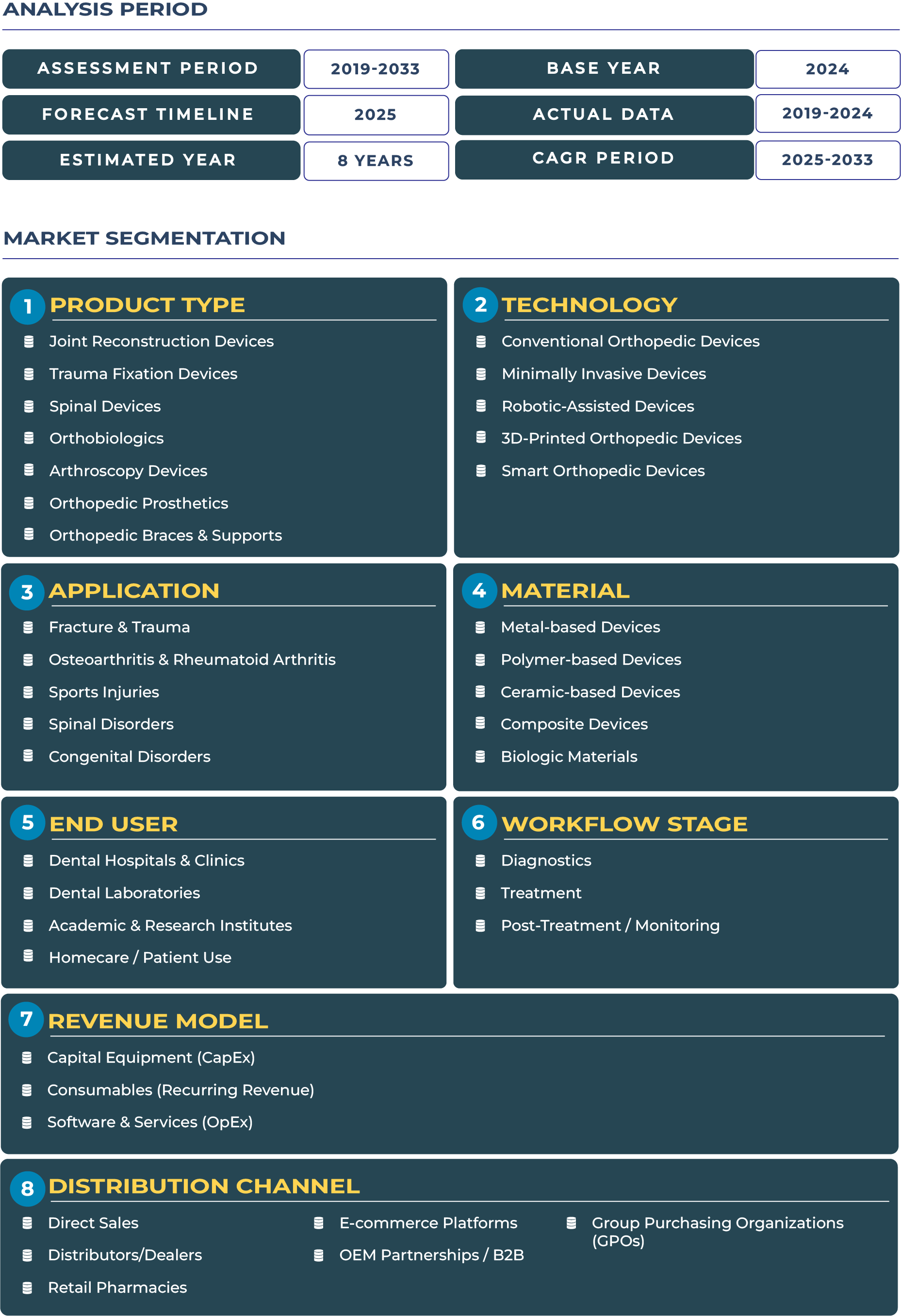Spain Orthopedic Devices Market Outlook: Sports Medicine as a Catalyst for Sustained Growth
Spain’s growing emphasis on sports and active lifestyles has positioned sports medicine as a key driver of the orthopedic devices market. With one of Europe’s most vibrant sporting cultures, the country reports a consistently high incidence of injuries linked to football, basketball, cycling, and tennis. This backdrop is fueling demand for trauma fixation devices, arthroscopy equipment, and joint reconstruction solutions. Supported by Spain’s universal healthcare coverage under the Ministry of Health, patients gain access to advanced orthopedic interventions, creating a strong base for device adoption across both public and private sectors.
The Spain Orthopedic Devices Market is projected to grow from USD 1.49 billion in 2025 to USD 2.24 billion by 2033, expanding at a CAGR of 5.2% (2025–2033). This performance is fueled by the convergence of multiple factors: a rising sports injury burden, an aging but active population, increasing investment by private hospital networks, and a steady inflow of medical tourism. Collectively, these dynamics underpin a resilient orthopedic devices ecosystem that is evolving rapidly despite broader fiscal pressures in Spain’s healthcare sector.
Demographic and Sports-Driven Orthopedic Market Expansion
Spain has a unique demographic profile—an aging population with one of Europe’s longest life expectancies, but also a strong emphasis on sports and active aging. This dual characteristic creates steady demand for both trauma fixation devices and joint replacement implants. For instance, older adults participating in recreational activities increasingly require orthopedic prosthetics and spinal stabilization devices due to age-related wear and injury. On the other hand, younger populations, particularly athletes, drive uptake of arthroscopy devices for minimally invasive sports injury management. This duality places Spain Orthopedic Devices industry at the intersection of demographic health needs and sports-related demand.
Why Sports Medicine is Fueling Orthopedic Growth in Spain
Spain Orthopedic Devices market outlook is shaped by the country’s strong healthcare infrastructure and high incidence of sports-related injuries. Trauma fixation and arthroscopy devices are particularly in demand due to the prevalence of knee, shoulder, and ligament injuries in athletes. The adoption of advanced imaging and minimally invasive surgical approaches within sports medicine is also accelerating the uptake of precision orthopedic devices. Furthermore, joint replacement procedures are increasing among aging adults, demonstrating how orthopedic demand spans across multiple patient categories.
Despite fiscal pressures on Spain’s public healthcare system, private hospitals are expanding specialized orthopedic wings, offering faster access to innovative solutions such as robotic-assisted joint surgeries. This diversification strengthens resilience in the orthopedic devices sector, providing balanced growth across both public and private ecosystems. With medical tourism focused on sports rehabilitation in regions such as Catalonia and Andalusia, Spain is positioning itself as a regional hub for orthopedic excellence.
Key Drivers and Restraints Shaping Spain Orthopedic Devices Landscape
Private Sector Growth and Orthobiologics Innovation Fuel Expansion
Spain Orthopedic Devices market benefits from robust private sector investment, with leading hospital groups in Madrid and Barcelona building orthopedic centers of excellence. These facilities are increasingly adopting orthobiologics, such as bone graft substitutes and growth factor therapies, which enhance healing and reduce recovery times. The interest in orthobiologics aligns with Spain’s proactive adoption of innovative therapies in sports medicine, catering to both professional athletes and active retirees. Furthermore, the rise of medical tourism for orthopedic surgeries, particularly in southern Spain, adds incremental demand for advanced implants and prosthetics.
Fiscal Austerity and Tender-Driven Pricing Pose Challenges
While growth prospects are strong, Spain Orthopedic Devices sector faces systemic challenges. Fiscal austerity measures in certain regions have slowed public procurement cycles, while highly competitive tenders pressure device manufacturers to cut prices. Fragmentation in regional healthcare governance further complicates procurement, as policies differ across autonomous communities. Additionally, slow adoption of reforms in some regions delays the integration of advanced technologies such as robotic-assisted surgery, hindering uniform growth across the market. These challenges create a bifurcated landscape where private hospitals adopt innovation rapidly while public hospitals navigate budgetary constraints.
Trends and Opportunities Defining Spain Orthopedic Devices Market
Ambulatory Surgery Uptake and Regional Consolidation of Orthopedic Care
Ambulatory surgery centers are expanding across Spain, particularly in metropolitan areas such as Madrid and Barcelona. This trend reflects the increasing adoption of minimally invasive arthroscopy devices and outpatient orthopedic care. Regional consolidation of orthopedic services into centers of excellence ensures better resource utilization and patient outcomes. This trend is reinforced by hospital group collaborations, which pool expertise and resources to deliver advanced orthopedic interventions. As patients demand faster recovery and minimally invasive options, ambulatory orthopedic surgery is becoming a defining trend in Spain’s healthcare delivery.
Tourism-Focused Orthopedic Care and Local Training as Market Opportunities
Spain has a strong opportunity to expand its medical tourism ecosystem by integrating orthopedic care with sports rehabilitation packages. Tourist hubs such as Valencia and Malaga already attract patients seeking affordable, high-quality joint reconstruction and trauma care. Bundled service packages that include rehabilitation and recovery in wellness resorts represent a new growth frontier. Moreover, investment in local clinical training partnerships with universities and international device manufacturers will strengthen Spain Orthopedic Devices ecosystem. These initiatives enhance access to cutting-edge devices and build sustainable expertise within the market.
Competitive Landscape: Global Leaders and Local Specialists Shaping Growth
The competitive landscape of Spain Orthopedic Devices industry is characterized by the presence of both international leaders and local companies. Multinational players such as Stryker and Zimmer Biomet have expanded their footprint in Spain, introducing advanced robotic-assisted joint replacement systems. Local companies collaborate with regional hospitals to provide tailored implants and prosthetics adapted to Spain’s regulatory environment. Private hospital groups increasingly form co-investments with distributors to secure access to innovative technologies, especially in high-demand areas like arthroscopy and spinal devices.
Strategically, companies are focusing on flexible pricing for public tenders and customized service packages for private hospitals. Tourism-focused orthopedic offerings are also emerging, where manufacturers partner with private clinics to deliver value-added services. This hybrid strategy ensures penetration into both public and private ecosystems, while leveraging Spain’s unique positioning in sports medicine and medical tourism.







